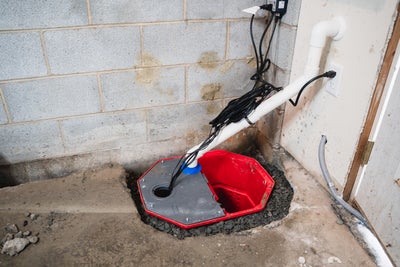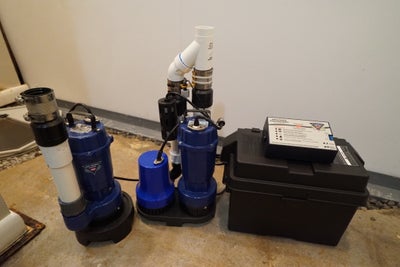The Ultimate Guide to Basement Sump Pumps

Flooding or even a small amount of water in the basement is every homeowner’s nightmare; it leads to mold, ruined belongings, and other costly damages. The best defense is a comprehensive basement waterproofing system, including a reliable sump pump.
While a sump pump is crucial for basement water management and removal, there are many options and factors to consider. How do you determine what’s best for your home?
We’ll cover all this and more in our complete guide to basement sump pumps.
What Is A Sump Pump?
First, let’s start by explaining what a sump pump is and its role in basement waterproofing.
A sump pump is a crucial appliance for collecting and actively removing leaking water from your basement. It works best when installed alongside other water management solutions. Consider it the “heart” of your basement waterproofing system.
Here’s how it works:
- A pit, referred to as the sump pit, is excavated in the basement’s lowest-lying area.
- A sump basin or liner is installed within this pit to house the essential pumping equipment.
- An interior drainage system—a network of trenches along the basement’s perimeter—is constructed to capture and channel any water seepage.
- These drainage trenches are strategically positioned to direct the accumulated water toward the sump pump system.
- The sump pump’s primary function is to collect the inflowing water within its basin.
- The pump automatically activates once the basin water level reaches a predetermined threshold.
- The activated pump expels the collected water through a series of discharge lines, ensuring it is drained and diverted away from your home.
Essential Sump Pump Components
While many household appliances come equipped with optional accessories aimed at enhancing functionality and convenience, certain features are essential for a sump pump to operate effectively. These features include:
- Sump Liner: A sump pump liner serves as a protective barrier, ensuring that your pump remains in optimal condition even when exposed to high moisture levels over extended periods.
- Sump Stands: These stands elevate the pump within the sump liner, preventing debris or sediment collected by the liner from damaging the pump.
- Airtight Lid: Water seeping into your home can carry an unpleasant odor. An airtight lid helps contain these odors, preventing them from permeating your living space.
- Alarm Systems: Without an alarm, sump pump failure may go unnoticed until your basement is already flooded. An alarm system alerts you immediately if the pump fails to activate, allowing you to address the issue promptly and mitigate potential damage.
- Antifreeze Lines: Pipes can freeze during cold weather, causing water to back up and potentially damage your pump. Antifreeze lines prevent this by providing an escape route for excess water, ensuring it can safely drain away from the pipes.
By incorporating these essential features into your sump pump system, you enhance its reliability, efficiency, and overall performance. This ultimately provides you with greater peace of mind and protection against potential water damage.
Do I Have Different Sump Pump Model Options?
Basement sump pumps come in various shapes and sizes. While this may seem overwhelming, it’s crucial because every home has different waterproofing needs. Here are seven of the most commonly used sump pump systems.
1. Pedestal Sump Pumps
The pedestal sump pump is mounted above the sump basin and positioned above the basement’s water line. It rests on a pipe that elevates it above the necessary water level and is equipped with a sensor that detects water entering the basin. When the water reaches a certain height, the sump pump’s motor activates, initiating the process of water elimination.
While pedestal sump pumps have a higher pumping capacity, they are noisy and prone to frequent malfunctions.
2. Submersible Sump Pumps

The submersible sump pump is installed directly into the sump pit and operates underwater. It is encased in a watertight housing and features a sensor that detects when water rises to a critical level within the pit. An impeller mechanism then pumps the excess water out of the basin through a connected drainage pipe, redirecting it outside the home to a designated drainage area.
Submersible sump pumps offer high capacity and a long lifespan but can be costly initially.
3. Water-Powered Sump Pumps
Water-powered sump pumps are installed above the pump pit and derive their power from your water supply instead of electricity. These systems rely on your municipality’s water supply and your home’s water pressure to generate the necessary pumping capacity.
While these systems don’t rely on electricity and often last for many years, they lack the pumping capacity of other systems and rely on high water pressure.
4. Floor Sucker Sump Pumps
Floor sucker pumps are designed for areas without existing sump systems and are distinguished by their portability. They are not permanently installed, allowing for use in multiple locations. The pump sits directly on the floor surface, unattached to any sump pit or drain. Floor sucker pumps are primarily used to drain excess water from floors rather than as protective devices, removing water that has already accumulated in flooded areas.
These pumps are ready to use immediately and don’t require additional solutions. However, they are loud, have a low pumping capacity, and do not prevent flooding.
5. Generator-Powered Sump Pumps
Generator-powered sump pumps operate similarly to standard sump pumps but derive their power from a generator rather than the electrical grid. The primary additional expense associated with this type of system comes from the installation and maintenance of the generator.
6. Battery-Powered Sump Pumps

Battery-powered sump pumps are the most popular backup option. These pumps are entirely independent, powered by a dedicated battery not connected to any other power source. Homeowners must ensure that the battery is always fully charged to maintain the pump’s readiness for operation.
7. AC-Powered Sump Pumps
Powered by a deep cycle battery and charged by an AC charger, these pumps operate as long as the battery has sufficient charge. This option is particularly effective for homes that frequently experience flooding incidents.
At Groundworks, our team meticulously researched and evaluated every sump pump model available on the market to determine the most reliable and effective options. This comprehensive process allows us to confidently recommend our submersible sump pump systems, which have varying pumping capacities and battery backups, for waterproofing your basement.
How to Maintain Your Basement Sump Pump

When selecting a basement sump pump, it’s crucial to consider the maintenance requirements necessary to ensure its continued operation. Sump pumps can be complex and delicate, particularly their internal components. It may be tempting to troubleshoot your sump pump on your own, but we strongly advise against it.
When an expert like Groundworks installs your basement sump pump, you can rely on us for ongoing support and maintenance services. During annual maintenance appointments, we thoroughly inspect your sump pump system to ensure it continues to function properly and promptly address any issues we encounter. Our sump pumps and other basement waterproofing systems are backed by comprehensive warranties, providing you with added peace of mind.
Do I Really Need a Basement Sump Pump?
All this sounds like a lot; we completely understand that. You may be wondering if a sump pump is truly necessary and worth the investment of time and resources. The answer is a resounding yes.
Even occasional instances of water seepage in your basement can lead to significant damage. Moisture is your home’s biggest enemy, as it can lead to mold growth, structural instability, and unhealthy living conditions for your family.
As the old adage goes, “An ounce of prevention is worth a pound of cure.” It’s best to have a reliable basement sump pump in place, ready to safeguard your home in case of water inundation. Why worry every time it rains? Invest in a dependable sump pump system and give yourself the peace of mind you deserve.
FAQs
It’s time to consider installing or upgrading your sump pump if you notice problems like water in your basement, mold, efflorescence, musty odors, and elevated humidity. These issues will not resolve themselves; contact Groundworks for a free inspection and sump pump estimate.
A battery backup sump pump can be particularly beneficial for homeowners who experience frequent power outages or spend extended periods away from their homes. Installing a sump pump system with a battery backup ensures that your basement remains protected against water intrusion, even during power interruptions, providing an added layer of security and peace of mind.
While it is possible to install a basement sump pump yourself, we don’t recommend it. A DIY installation requires significant time and effort, and most manufacturer warranties are limited for self-installations. Additionally, many off-the-shelf sump pumps lack essential features like airtight lids and pump stands, compromising their performance and longevity. For optimal results and peace of mind, seek professional installation services from Groundworks.
Trust Groundworks With Your Basement Sump Pump Needs

Basement leaks can undoubtedly be a source of anxiety, but they shouldn’t instill a sense of dread every time it rains. At Groundworks, our mission is to empower homeowners to face wet weather confidently, offering reliable sump pump installations and comprehensive basement waterproofing solutions.
Our team understands the unique weather challenges faced across Northern and Southern Alberta. Our powerful sump pumps handle even the most severe rainfall and flooding, ensuring your home remains safe and dry all year. Contact us to schedule a free inspection and estimate.